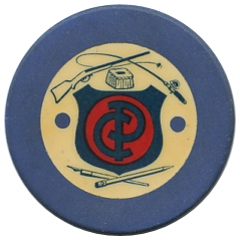|
|
|

The scans below represent my best guess as to evolution of crest and seals and eventual devolution of c&s into what one would call plain molds with inlays.
At the turn of the century the most noted maker of pinbacks was Whitehead and Hoag out of Newark, NJ. The lithos that were used on their pinbacks were made out of paper and covered by celluloid. This "litho sandwich" was wrapped around a tin dish and held in place by a metal ring. At some point in time, some of the pinback lithos made their way over to USPC to be inlayed into a clay chip. This became the first crest & seal. (see the 3 chips in the 1890s to 1900s section).
A problem with the W&H poker chips was the that, unlike with pinbacks where there is a ring to secure the litho, the poker chip inlays were not secured in the chip. Eventually the inlay warped or lifted. Somewhere around 1910 USPC, which produced its own lithos in the making of playing cards, began producing its own poker chip litho inlays. Rather than used the W&H paper/celluloid formula, they used celluloid/celluloid. Unlike with paper/celluloid, these inlays dried flat --- no lifing of inlays. I assume USPC was not sure they would not lift because chips made between 1910 and 1917 has one or two holes in the body of the inlay so that the clay would have something to bite on to when the inlay was pressed in. (see Cuvier Press Club and Keno chips below) After 1917 or so, the company realized that such holes were not necessary and discontinued the practice.
In the late 1940s Burt took over making poker chips. (There was, most likey, an overlap of a couple of years where both USPC and Burt produced chips). Burt employed a similar manufacturing process to USPC. The differences I can see are: Burt used a smaller inlay, Burt used plastic rather than celluloid (celluloid was quite flamable and produced extremely toxic smoke. Celluloid was also quite expensive and had to be imported from Italy). I also notice that, over time, USPC inlays yellow while Burt inlays stay white forever. Also, Burt colors never quite matched USPC colors.
In the late 1950s through the 1960s, the c&s inlay began to devolve. I assume it was a cost savings measure that thinned out the clear outer plastic covering. There is very little protection on these inlays (Dunes, Flaming inlays).
Lastly in the 1970 we have what I call plain molds with inlays. The covering or seal is all but vanished. They are not c&s.
Again, the forementioned is my best guess of how things went. Any corrections would be appreciated.







|
|